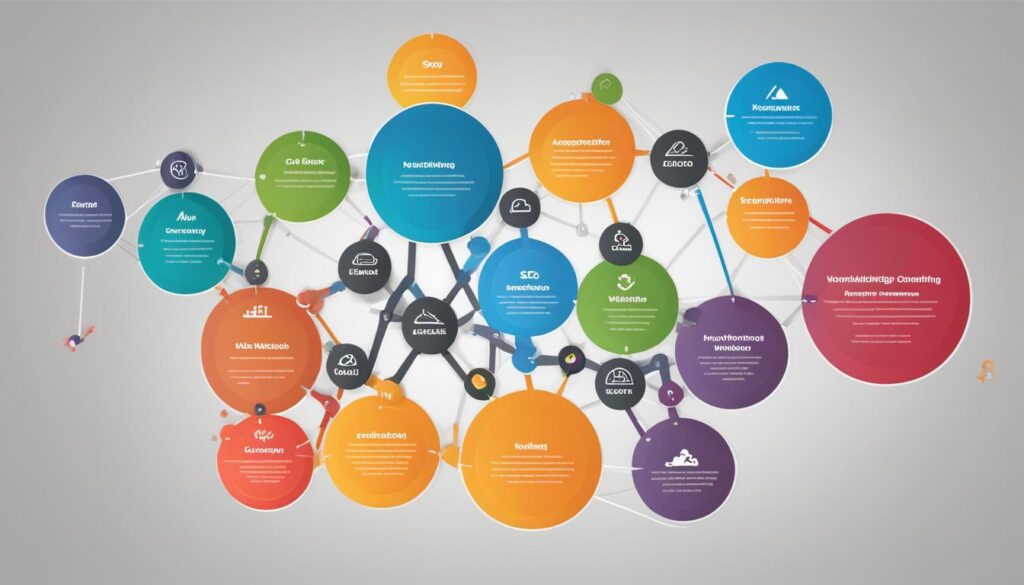
Building a successful website requires a strategic approach, not just haphazard design choices. Understanding your target audience and setting clear objectives are key factors in developing a website that meets their needs. A content strategy that incorporates compelling and relevant video content optimized for SEO can boost your website's visibility and engagement.
Video content has become increasingly popular in the digital landscape. It offers a dynamic and immersive way to convey information, engage users, and drive conversions. When integrated strategically, videos can enhance your website's SEO and deliver a seamless user experience.
Key Takeaways:
- Understanding your target audience and setting clear objectives are essential in developing an effective website.
- Video content optimized for SEO can significantly improve your website's visibility and engagement.
- Incorporating compelling and relevant video content enhances the overall user experience.
- Integrating videos strategically contributes to a user-focused design and improves the website's conversion rate.
- By prioritizing video content in your website's content strategy, you can enhance your website's SEO and drive meaningful results.
Understanding Your Audience and Setting Clear Objectives
When it comes to designing a successful website, one cannot underestimate the importance of audience research and setting clear objectives. Understanding your target audience and defining their preferences through comprehensive research can guide the design process and ensure maximum user engagement.
By creating target personas based on your findings, you can effectively tailor your website to meet the needs and expectations of your audience. These personas serve as a representation of your ideal users, providing valuable insights into their motivations, behaviors, and pain points.
However, audience research alone is not enough. It is essential to align your objectives with your business goals to create a purpose-driven website. Setting measurable objectives enables you to track progress, gauge success, and make data-driven decisions. By establishing key performance indicators (KPIs) and defining specific goals, you can effectively measure the impact of your website on your business.
Translating Objectives into User-Centric Design
Simply setting objectives is not sufficient; they must be integrated into the design process. A user-centric design approach ensures that your website caters to the needs, expectations, and desires of your target audience. By focusing on user experience and incorporating their feedback, you can create a website that resonates with your visitors and encourages them to engage further.
Consider user-centric design as a holistic approach that takes into account factors such as ease of navigation, intuitive layout, and clear messaging. By conducting usability tests and analyzing user behavior, you can refine your website's design and optimize it for enhanced user experience.

By understanding your audience and setting clear objectives, you can create a website that not only attracts visitors but also engages and converts them into loyal customers. By putting your users at the forefront of your design decisions, you can build trust, establish credibility, and deliver a seamless and personalized experience.
Developing a Content Strategy and User-Focused Information Architecture
When it comes to website development, creating compelling and relevant content that is optimized for SEO is a crucial component of a successful strategy. By incorporating diverse multimedia elements and optimizing the user interface for mobile users, you can enhance engagement and provide a seamless experience across devices.
A user-focused information architecture plays a vital role in guiding users through your website. By implementing streamlined navigation and organizing content with a clear hierarchy, you can ensure that visitors can easily find what they're looking for, leading to improved user satisfaction and increased time spent on your website.

Furthermore, responsive design is paramount in today's digital landscape. With a responsive website, you can ensure that your content is accessible and easily viewable on various devices, regardless of screen size. This not only improves user experience but also contributes to SEO optimization, as search engines prioritize websites with responsive design.
In summary, developing a content strategy that focuses on compelling content, SEO optimization, multimedia engagement, streamlined navigation, content hierarchy, and responsive design is essential for creating a user-friendly and successful website. By understanding and catering to the needs of your audience, you can enhance their overall experience and drive greater engagement and conversions.
Intuitive and Aesthetically Pleasing Design and Conversion-Focused Elements
When it comes to designing a successful website, functionality and visual appeal are two essential factors to consider. An intuitive design ensures that visitors can easily navigate through your website and find the information they need. To achieve this, it's crucial to choose an appropriate color scheme and typography that aligns with your brand image. Consistency in branding across all web pages helps build recognition and trust with your audience.
"A well-designed website creates a positive first impression and encourages users to explore further."
Strategic Call-to-Actions (CTAs) play a significant role in guiding visitors towards desired actions, such as making a purchase or filling out a form. By strategically placing CTAs throughout your website, you can effectively lead users down the conversion path.
But the design isn't just about aesthetics. It's also about creating an optimal user experience. User-friendly forms that are easy to fill out and submit enhance visitor satisfaction and increase the likelihood of conversions. Implementing trust-building elements, such as customer testimonials and security badges, helps establish credibility and makes visitors more comfortable sharing their information.
Key Elements for an Intuitive and Aesthetically Pleasing Website Design
| Element | Description |
|---|---|
| Color Scheme | Choosing harmonious colors that reflect your brand and evoke the desired emotions. |
| Typography | Selecting fonts that are easy to read and align with your brand image. |
| Consistent Branding | Using consistent logos, colors, and visuals to reinforce your brand identity. |
| Strategic CTAs | Placing compelling CTAs in prominent locations to drive conversions. |
| User-Friendly Forms | Creating forms that are intuitive, easy to complete, and require minimal effort from users. |
| Trust-Building Elements | Adding elements such as testimonials, reviews, and security badges to build trust with visitors. |
An aesthetically pleasing and functional website design increases user engagement, encourages conversions, and leaves a lasting impression on visitors. By incorporating these key design elements into your website, you can create an immersive user experience that fosters trust and drives results.
Conclusion
Enhancing website SEO with strategic video content is a powerful way to boost visibility and engagement. By understanding your audience, setting clear objectives, and developing a content strategy that incorporates video content optimized for SEO, you can create a user-focused website with intuitive design elements.
Prioritizing the user experience and implementing conversion-focused elements contribute to the overall success of your website. Strategic design choices that balance functionality and visual appeal, such as an appropriate color scheme and typography, consistent branding, and strategically placed CTAs, enhance the user experience and drive engagement.
By incorporating these strategies, your website will not only elevate its SEO, but also provide a seamless user experience and generate meaningful results. The combination of compelling video content, strategic design, and a user-centric approach fosters engagement and positions your website for success in an increasingly competitive digital landscape.
FAQ
How can video content enhance website SEO?
Video content can enhance website SEO by providing valuable multimedia elements that engage users and boost visibility. When optimized with relevant keywords, video content can improve search engine rankings and increase website traffic.
Why is understanding your audience important in website design?
Understanding your audience is important in website design because it allows you to cater to their preferences and create a user-centric design. By knowing their needs and expectations, you can develop a website that meets their requirements, enhancing their overall experience.
What are target personas and why are they relevant in website design?
Target personas are fictional representations of your ideal audience members. They help you understand your audience better by including demographic information, preferences, and behaviors. Target personas are relevant in website design as they guide design choices to cater to specific audience segments.
How can clear objectives contribute to website success?
Clear objectives that align with your business goals help track and measure website success. They provide a roadmap for designing the website and allow you to assess whether the website is meeting its intended purpose.
Why is a content strategy important for website design?
A content strategy is important for website design because it ensures the creation of compelling and relevant content. By optimizing content for SEO and incorporating diverse multimedia elements, the website becomes more engaging and appealing to users.
What is the role of information architecture in website design?
Information architecture plays a crucial role in website design as it focuses on organizing and structuring content in a user-friendly way. Streamlined navigation and a clear content hierarchy help users find information easily, enhancing their overall experience.
How does responsive design benefit a website?
Responsive design benefits a website by ensuring optimal viewing and functionality across devices. It creates a user-friendly and inclusive environment, allowing users to access and interact with the website seamlessly, regardless of the device they are using.
How does the design of a website impact user engagement?
The design of a website impacts user engagement by balancing functionality and visual appeal. Choosing an appropriate color scheme, typography, and incorporating consistent branding creates a cohesive and aesthetically pleasing experience. Strategic placement of CTAs and user-friendly forms enhance engagement and contribute to successful conversions.
What are conversion-focused elements in website design?
Conversion-focused elements in website design are features that encourage users to take desired actions, such as making a purchase or signing up for a newsletter. User-friendly forms, trust-building elements, and strategically placed CTAs are examples of conversion-focused elements that contribute to successful conversions.
How can video content and strategic design elements enhance website SEO?
Video content, when optimized for SEO, can improve website visibility by increasing search engine rankings. Strategic design elements, such as a user-centric design, intuitive navigation, and engaging multimedia, enhance the overall user experience and contribute to improved SEO performance.











